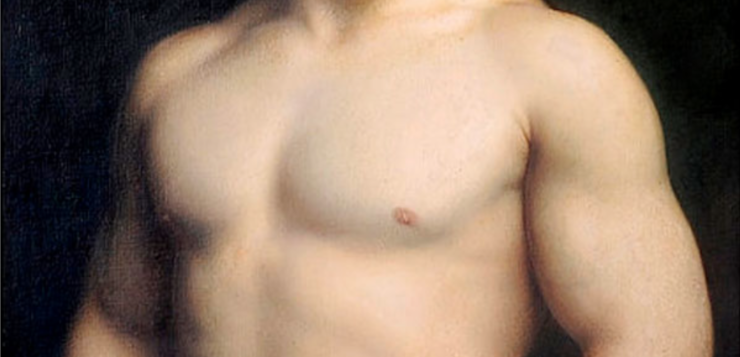A PORTRAIT of strongman and wrestler Maurice Deriaz (1885–1974) executed by Gustave Courtois (1852–1923) in 1907 has not been forgotten. It currently makes the rounds on social media sites dedicated to the male figure or to artistic images of masculine bodies. But regardless of the medium, the portrait seduces the viewer through its beautiful depiction of Deriaz’ manly physique and its palpable eroticism.
In this half-length portrait, Deriaz stands slightly turned to the right. The flawless porcelain-white skin of the brawny exposed chest stands out against the dark, blurred background. A light blue sash with a silver lining hugs the waist below the navel, tied in a knot on Deriaz’ left hip. The light shines brightest on the middle of the hairless chest and the left clavicle, creating shadows on the right side of the body. The gracefully flexed arms allow the biceps to bulge slightly as the left hand gently clasps the right hand below the sash. Lush brown hair crowns the proud face while the curvatures of the bushy eyebrows—echoed by the discrete moustache over thin carmine lips—frame the seductive gaze from eyes looking intensely towards the left, avoiding direct contact with the viewer.

For a portrait artist of Gustave Courtois’ caliber, the work signaled a bold statement. A bare-chested wrestler and bodybuilder was out of place in the polite society usually associated with academic art at the time. When shown at the Paris Salon of 1907, it raised many eyebrows among critics. One journalist accused Courtois of bad taste for showing the athlete bare-chested, while another speculated on the artist’s experience of pleasure while executing the work: “What intense pleasure M. Gustave Courtois must have felt while giving shape to the triumphant torso of the athlete Maurice de Riaz! How he has caressed its sinuous contours!” Without a doubt, the critics’ uneasiness upon seeing the portrait lay bare the homoerotic content of the piece and hinted at Courtois’ “deviant” sexuality, raising suspicions about the relationship between the artist and model. But who were Courtois and Deriaz, and what was the nature of their relationship?
Eduardo A. Febles is Professor of French and Francophone Studies at Simmons University in Boston.








Discussion1 Comment
Fascinating article. I’d love to read Professor Febles’ take on two other 19th-century French artists of special queer interest, Antoine Chintreuil (one of the original Parisian Bohemians, who had a lifelong, much younger companion) and Gustave Boulanger (whose Hercules of 1861 is still a jaw-dropper, and who had a very curious personal life).